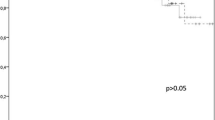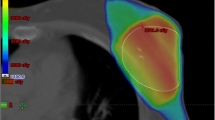Background and Purpose:
Breast irradiation after lumpectomy is an integral component of breast-conserving therapy (BCT). As the prognosis is general good following BCT, late morbidity and cosmesis are important. The present study compares two different radiation schedules with respect to these two endpoints.
Patients and Methods:
129 breast cancer patients (pT1–2 pN0–1 cM0) were irradiated between 09/1992 and 08/1994 with either a 22-day fractionation schedule (2.5 Gy to 55 Gy, 4×/week, n = 65) or with a conventional fractionation schedule (28 days, 2.0 Gy to 55 Gy, 5×/week, n = 64), both without additional boost. The equivalent dose of 2-Gy fractions (EQD2) was 55 Gy and 62 Gy, respectively. Late toxicity, assessed according to the LENT-SOMA criteria, and cosmetic outcome, graded on a 5-point scale, were evaluated after a median of 86 months (range 72–94 months) in tumor-free breast cancer patients.
Results:
LENT-SOMA grade 2/3 toxicity (2.5 Gy vs. 2.0 Gy): breast pain (18% vs. 11%; p = 0.3), fibrosis (57% vs. 16%; p < 0.001), telangiectasia (22% vs. 3%; p = 0.002), atrophy (31% vs. 3%; p < 0.001). Medication to breast pain was taken by 8% versus 9% of patients. Cosmesis was very good/good/acceptable in 75% versus 93% (2.5 Gy vs. 2.0 Gy; p = 0.006).
Conclusion:
Late morbidity was significantly frequent and cosmesis was significantly worse after hypofractionated radiotherapy (2.5 Gy to 55 Gy). However, morbidity was not associated with major implications on daily life.
Hintergrund und Ziel:
Die adjuvante Bestrahlung der Brust nach Operation ist ein integraler Bestandteil der brusterhaltenden Therapie (BET). Da die Prognose nach BET sehr gut ist, stellen die Spättoxizität und Kosmetik wichtige Untersuchungsparameter dar. Die vorliegende Untersuchung vergleicht zwei unterschiedliche Fraktionierungsschemata in Bezug auf diese Endpunkte.
Patienten und Methodik:
129 Patientinnen mit Brustkrebs (pT1–2 pN0–1 cM0) wurden zwischen 09/1992 und 08/1994 entweder mit einem 22-Tage-Fraktionierungsschema (2,5 Gy bis 55 Gy, 4×/Woche, n = 65) oder mit einem 28-Tage-Fraktionierungsschema (2,0 Gy bis 55 Gy, 5×/Woche, n = 64), jeweils ohne Boost, behandelt. Die Äquivalentdosis für 2 Gy pro Fraktion betrug 55 Gy und 62 Gy. Die Spätnebenwirkungen (LENT-SOMA) und das kosmetische Ergebnis (5-Punkte-Skala) wurden erfasst (mittlere Nachbeobachtungszeit 86 Monate, 72–94 Monate).
Ergebnisse:
Folgende LENT-SOMA-Nebenwirkungen Grad 2/3 (2,5 Gy vs. 2,0 Gy) traten auf: Brustschmerzen (18% vs. 11%; p = 0,3), Fibrose (57% vs. 16%; p < 0,001), Teleangiektasien (22% vs. 3%; p = 0,002), Atrophie (31% vs. 3%; p < 0,001). Schmerzmittel wurden von 8% versus 9% der Patientinnen eingenommen. Das kosmetische Ergebnis war sehr gut/gut/moderat in 75% versus 93% (2,5 Gy vs. 2,0 Gy; p = 0,006).
Schlussfolgerung:
Im eigenen Kollektiv ist die Häufigkeit von Spätnebenwirkungen und beeinträchtigter Kosmetik nach hypofraktionierter Strahlentherapie signifikant erhöht, allerdings ohne wesentliche Einschränkungen für den Alltag.
Similar content being viewed by others
Author information
Authors and Affiliations
Corresponding author
Rights and permissions
About this article
Cite this article
Fehlauer, F., Tribius, S., Alberti, W. et al. Late Effects and Cosmetic Results of Conventional Versus Hypofractionated Irradiation in Breast-Conserving Therapy. Strahlenther Onkol 181, 625–631 (2005). https://doi.org/10.1007/s00066-005-1404-9
Received:
Revised:
Issue Date:
DOI: https://doi.org/10.1007/s00066-005-1404-9




